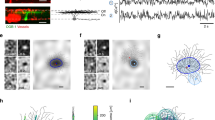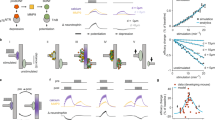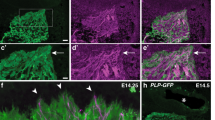Abstract
Sensory neurons with common functions are often nonrandomly arranged and form dendritic territories that show little overlap, or tiling. Repulsive homotypic interactions underlie such patterns in cell organization in invertebrate neurons. It is unclear how dendro-dendritic repulsive interactions can produce a nonrandom distribution of cells and their spatial territories in mammalian retinal horizontal cells, as mature horizontal cell dendrites overlap substantially. By imaging developing mouse horizontal cells, we found that these cells transiently elaborate vertical neurites that form nonoverlapping columnar territories on reaching their final laminar positions. Targeted cell ablation revealed that the vertical neurites engage in homotypic interactions that result in tiling of neighboring cells before the establishment of their dendritic fields. This developmental tiling of transient neurites correlates with the emergence of a nonrandom distribution of the cells and could represent a mechanism that organizes neighbor relationships and territories of neurons before circuit assembly.
This is a preview of subscription content, access via your institution
Access options
Subscribe to this journal
Receive 12 print issues and online access
$209.00 per year
only $17.42 per issue
Buy this article
- Purchase on Springer Link
- Instant access to full article PDF
Prices may be subject to local taxes which are calculated during checkout







Similar content being viewed by others
References
Gan, W.B. & Macagno, E.R. Interactions between segmental homologs and between isoneuronal branches guide the formation of sensory terminal fields. J. Neurosci. 15, 3243–3253 (1995).
Grueber, W.B., Ye, B., Moore, A.W., Jan, L.Y. & Jan, Y.N. Dendrites of distinct classes of Drosophila sensory neurons show different capacities for homotypic repulsion. Curr. Biol. 13, 618–626 (2003).
Sugimura, K. et al. Distinct developmental modes and lesion-induced reactions of dendrites of two classes of Drosophila sensory neurons. J. Neurosci. 23, 3752–3760 (2003).
Wassle, H., Peichl, L. & Boycott, B.B. Mosaics and territories of cat retinal ganglion cells. Prog. Brain Res. 58, 183–190 (1983).
Vaney, D.I. The mosaic of amacrine cells in the mammalian retina. Prog. Retin. Res. 9, 49–100 (1990).
Raven, M.A., Stagg, S.B., Nassar, H. & Reese, B.E. Developmental improvement in the regularity and packing of mouse horizontal cells: implications for mechanisms underlying mosaic pattern formation. Vis. Neurosci. 22, 569–573 (2005).
Hinds, J.W. & Hinds, P.L. Differentiation of photoreceptors and horizontal cells in the embryonic mouse retina: an electron microscopic, serial section analysis. J. Comp. Neurol. 187, 495–511 (1979).
Schnitzer, J. & Rusoff, A.C. Horizontal cells of the mouse retina contain glutamic acid decarboxylase–like immunoreactivity during early developmental stages. J. Neurosci. 4, 2948–2955 (1984).
Poche, R.A. et al. Somal positioning and dendritic growth of horizontal cells are regulated by interactions with homotypic neighbors. Eur. J. Neurosci. 27, 1607–1614 (2008).
Rossi, C., Strettoi, E. & Galli-Resta, L. The spatial order of horizontal cells is not affected by massive alterations in the organization of other retinal cells. J. Neurosci. 23, 9924–9928 (2003).
Chattopadhyaya, B. et al. Experience and activity-dependent maturation of perisomatic GABAergic innervation in primary visual cortex during a postnatal critical period. J. Neurosci. 24, 9598–9611 (2004).
Peichl, L. & Gonzalez-Soriano, J. Morphological types of horizontal cell in rodent retinae: a comparison of rat, mouse, gerbil and guinea pig. Vis. Neurosci. 11, 501–517 (1994).
Haverkamp, S. & Wassle, H. Immunocytochemical analysis of the mouse retina. J. Comp. Neurol. 424, 1–23 (2000).
Ramón y Cajal, S. Studies on vertebrate neurogenesis (Thomas, Springfield, Illinois, 1960).
Reese, B.E., Raven, M.A. & Stagg, S.B. Afferents and homotypic neighbors regulate horizontal cell morphology, connectivity and retinal coverage. J. Neurosci. 25, 2167–2175 (2005).
Edqvist, P.H. & Hallbook, F. Newborn horizontal cells migrate bi-directionally across the neuroepithelium during retinal development. Development 131, 1343–1351 (2004).
Reese, B.E., Harvey, A.R. & Tan, S.S. Radial and tangential dispersion patterns in the mouse retina are cell-class specific. Proc. Natl. Acad. Sci. USA 92, 2494–2498 (1995).
Reese, B.E., Necessary, B.D., Tam, P.P., Faulkner-Jones, B. & Tan, S.S. Clonal expansion and cell dispersion in the developing mouse retina. Eur. J. Neurosci. 11, 2965–2978 (1999).
Rodieck, R.W. The density recovery profile: a method for the analysis of points in the plane applicable to retinal studies. Vis. Neurosci. 6, 95–111 (1991).
Blanks, J.C., Adinolfi, A.M. & Lolley, R.N. Synaptogenesis in the photoreceptor terminal of the mouse retina. J. Comp. Neurol. 156, 81–93 (1974).
Young, R.W. Cell proliferation during postnatal development of the retina in the mouse. Brain Res. 353, 229–239 (1985).
Rich, K.A., Zhan, Y. & Blanks, J.C. Migration and synaptogenesis of cone photoreceptors in the developing mouse retina. J. Comp. Neurol. 388, 47–63 (1997).
Sherry, D.M., Wang, M.M., Bates, J. & Frishman, L.J. Expression of vesicular glutamate transporter 1 in the mouse retina reveals temporal ordering in development of rod vs. cone and ON vs. OFF circuits. J. Comp. Neurol. 465, 480–498 (2003).
Sharma, R.K., O'Leary, T.E., Fields, C.M. & Johnson, D.A. Development of the outer retina in the mouse. Brain Res. Dev. Brain Res. 145, 93–105 (2003).
Godinho, L. et al. Nonapical symmetric divisions underlie horizontal cell layer formation in the developing retina in vivo. Neuron 56, 597–603 (2007).
Godinho, L. et al. Targeting of amacrine cell neurites to appropriate synaptic laminae in the developing zebrafish retina. Development 132, 5069–5079 (2005).
Nadarajah, B., Alifragis, P., Wong, R.O. & Parnavelas, J.G. Neuronal migration in the developing cerebral cortex: observations based on real-time imaging. Cereb. Cortex 13, 607–611 (2003).
Solecki, D.J., Model, L., Gaetz, J., Kapoor, T.M. & Hatten, M.E. Par6alpha signaling controls glial-guided neuronal migration. Nat. Neurosci. 7, 1195–1203 (2004).
Bellion, A., Baudoin, J.P., Alvarez, C., Bornens, M. & Metin, C. Nucleokinesis in tangentially migrating neurons comprises two alternating phases: forward migration of the Golgi/centrosome associated with centrosome splitting and myosin contraction at the rear. J. Neurosci. 25, 5691–5699 (2005).
Schaar, B.T. & McConnell, S.K. Cytoskeletal coordination during neuronal migration. Proc. Natl. Acad. Sci. USA 102, 13652–13657 (2005).
Eglen, S.J., van Ooyen, A. & Willshaw, D.J. Lateral cell movement driven by dendritic interactions is sufficient to form retinal mosaics. Network 11, 103–118 (2000).
Lin, B., Wang, S.W. & Masland, R.H. Retinal ganglion cell type, size and spacing can be specified independent of homotypic dendritic contacts. Neuron 43, 475–485 (2004).
Farajian, R., Raven, M.A., Cusato, K. & Reese, B.E. Cellular positioning and dendritic field size of cholinergic amacrine cells are impervious to early ablation of neighboring cells in the mouse retina. Vis. Neurosci. 21, 13–22 (2004).
Raven, M.A., Oh, E.C., Swaroop, A. & Reese, B.E. Afferent control of horizontal cell morphology revealed by genetic respecification of rods and cones. J. Neurosci. 27, 3540–3547 (2007).
Jeyarasasingam, G., Snider, C.J., Ratto, G.M. & Chalupa, L.M. Activity-regulated cell death contributes to the formation of ON and OFF alpha ganglion cell mosaics. J. Comp. Neurol. 394, 335–343 (1998).
Galli-Resta, L., Novelli, E. & Viegi, A. Dynamic microtubule-dependent interactions position homotypic neurones in regular monolayered arrays during retinal development. Development 129, 3803–3814 (2002).
Novelli, E., Leone, P., Resta, V. & Galli-Resta, L. A three-dimensional analysis of the development of the horizontal cell mosaic in the rat retina: implications for the mechanisms controlling pattern formation. Vis. Neurosci. 24, 91–98 (2007).
Tyler, M.J., Carney, L.H. & Cameron, D.A. Control of cellular pattern formation in the vertebrate inner retina by homotypic regulation of cell-fate decisions. J. Neurosci. 25, 4565–4576 (2005).
McCabe, K.L., Gunther, E.C. & Reh, T.A. The development of the pattern of retinal ganglion cells in the chick retina: mechanisms that control differentiation. Development 126, 5713–5724 (1999).
Perry, V.H. & Linden, R. Evidence for dendritic competition in the developing retina. Nature 297, 683–685 (1982).
Hitchcock, P.F. Exclusionary dendritic interactions in the retina of the goldfish. Development 106, 589–598 (1989).
Sagasti, A., Guido, M.R., Raible, D.W. & Schier, A.F. Repulsive interactions shape the morphologies and functional arrangement of zebrafish peripheral sensory arbors. Curr. Biol. 15, 804–814 (2005).
Stacy, R.C. & Wong, R.O. Developmental relationship between cholinergic amacrine cell processes and ganglion cell dendrites of the mouse retina. J. Comp. Neurol. 456, 154–166 (2003).
Shelley, J. et al. Horizontal cell receptive fields are reduced in connexin57-deficient mice. Eur. J. Neurosci. 23, 3176–3186 (2006).
Roberts, M.R., Srinivas, M., Forrest, D., Morreale de Escobar, G. & Reh, T.A. Making the gradient: thyroid hormone regulates cone opsin expression in the developing mouse retina. Proc. Natl. Acad. Sci. USA 103, 6218–6223 (2006).
Morgan, J.L., Schubert, T. & Wong, R.O. Developmental patterning of glutamatergic synapses onto retinal ganglion cells. Neural Develop. 3, 8 (2008).
Acknowledgements
We wish to thank S. Eglen (Cambridge University) and members of the Wong lab for many helpful discussions. This work was supported by US National Institutes of Health grants to R.O.L.W. (EY17101) and J.Z.H., and a National Research Service Award pre-doctoral fellowship to R.M.H.
Author information
Authors and Affiliations
Contributions
R.M.H. and R.O.L.W. conceived the study and wrote the manuscript. R.O.L.W. supervised the project. R.M.H., T.S., J.L.M. and L.G. carried out the experiments and/or data analysis. J.L.M. wrote the MatLab routines for the analysis. G.D.C. and Z.J.H. provided the G42 mice. All authors contributed to preparation of the manuscript.
Corresponding author
Supplementary information
Supplementary Text and Figures
Supplementary Figures 1–7 (PDF 1500 kb)
Supplementary Video 1
Time-lapse movie of cell shown in Figure 3b. (AVI 740 kb)
Supplementary Video 2
Time course showing extension of neurites into a region where two horizontal cells (grey) were ablated. Note that even after the region was filled in by the neurites of neighboring cells, the arbors of each cell remodeled over time, but formed non-overlapping territories at each time point (compare last two time points at 4.75 h and 8.75 h). (MOV 3801 kb)
Supplementary Video 3
An example showing neurites directed towards the ablation zone in a P3 retina. Time between frames, first post-ablation image captured 10 min after ablation. All other frames are about 1 h apart, except for the last two time points, which were about 2 h apart. Total recording duration following ablation was 10.5 hours. (MOV 3514 kb)
Supplementary Video 4
Example of a large ablation in a P2 retina: a total of 18 cells were ablated within 2 h. We analyzed 20 cells surrounding the ablation zone for cell body movement and movement of the center of mass of their territories. There was a significant inward movement of the cell bodies (sign test, P < 0.001) with an average soma displacement of 5.3 ± 0.8 μm. This gives the impression of a distortion in the matrix of surrounding cells, although some cell bodies clearly did not move, whereas others appeared displaced towards the vacated region. Redirection of neurites towards the ablation zone was, as with other ablations, clearly evident. Post-ablation image acquired at 12 h. (MOV 2048 kb)
Rights and permissions
About this article
Cite this article
Huckfeldt, R., Schubert, T., Morgan, J. et al. Transient neurites of retinal horizontal cells exhibit columnar tiling via homotypic interactions. Nat Neurosci 12, 35–43 (2009). https://doi.org/10.1038/nn.2236
Received:
Accepted:
Published:
Issue Date:
DOI: https://doi.org/10.1038/nn.2236
This article is cited by
-
Disruption in murine Eml1 perturbs retinal lamination during early development
Scientific Reports (2020)
-
Live imaging of developing mouse retinal slices
Neural Development (2018)
-
Ensheathing cells utilize dynamic tiling of neuronal somas in development and injury as early as neuronal differentiation
Neural Development (2018)
-
Homeostatic plasticity shapes the visual system’s first synapse
Nature Communications (2017)



